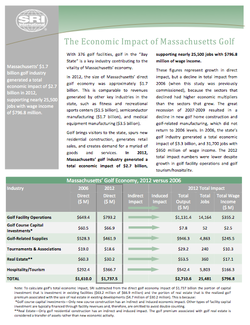measuring economic impact

Golf is so much more than just a game. It is a
significant industry, a major contributor to the American economy and
to the economic vitality of individual states. GOLF 20/20 published its
first national report in 2002, which demonstrated that golf in 2000 was a
$62 billion industry, bigger than the motion picture and recording
industries combined. A follow-up report conducted in 2011 reported that
golf had grown to a $68.8 billion industry, with a total impact on the
U.S. economy in 2011 of $167.8 billion.
Additionally, the recent report indicates that golf is responsible for contributing about $3.9 billion annually to charities across the country.
Click here for links to past Economic Impact Reports
Here are some frequently asked questions about this important report.
What is an Economic Impact Study?
In 2002, Golf 20/20 published its first national report, which demonstrated that golf in 2000 was a $62 billion industry, bigger than the motion picture and recording industries combined. A follow-up report conducted in 2011 reported that golf had grown to a $68.8 billion industry, with a total impact on the U.S. economy in 2011 of $167.8 billion. Additionally, the recent report indicates that golf is responsible for contributing about $3.9 billion annually to charities across the country.
Who conducts the Economic Impact Study
In 2006, along with research partner SRI International, GOLF 20/20 developed a template with which individual states can affordably quantify golf's impact on their economy; to date 33 states have used or are currently using this template, and the resulting reports have been successful in establishing golf as a critical cog in the state's economic engine.
Who benefits from this study?
Everyone who has a stake in the future of the golf industry. The Economic Impact Studies tells an important story about golf and its importance to the Massachusetts economy. Beyond its sport and recreational value, golf forms the nucleus of a major industry cluster that generates jobs, commerce, economic development, and tax revenues for communities throughout the Commonwealth.
This report has been instrumental in educating media, lawmakers and community leaders about our industry to help protect our game for future years.
Additionally, the recent report indicates that golf is responsible for contributing about $3.9 billion annually to charities across the country.
Click here for links to past Economic Impact Reports
Here are some frequently asked questions about this important report.
What is an Economic Impact Study?
In 2002, Golf 20/20 published its first national report, which demonstrated that golf in 2000 was a $62 billion industry, bigger than the motion picture and recording industries combined. A follow-up report conducted in 2011 reported that golf had grown to a $68.8 billion industry, with a total impact on the U.S. economy in 2011 of $167.8 billion. Additionally, the recent report indicates that golf is responsible for contributing about $3.9 billion annually to charities across the country.
Who conducts the Economic Impact Study
In 2006, along with research partner SRI International, GOLF 20/20 developed a template with which individual states can affordably quantify golf's impact on their economy; to date 33 states have used or are currently using this template, and the resulting reports have been successful in establishing golf as a critical cog in the state's economic engine.
Who benefits from this study?
Everyone who has a stake in the future of the golf industry. The Economic Impact Studies tells an important story about golf and its importance to the Massachusetts economy. Beyond its sport and recreational value, golf forms the nucleus of a major industry cluster that generates jobs, commerce, economic development, and tax revenues for communities throughout the Commonwealth.
This report has been instrumental in educating media, lawmakers and community leaders about our industry to help protect our game for future years.
